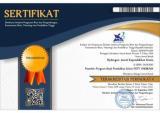Ethno-chemistry: Relevance Analysis of Electron Valence Subject Material to Sasak Local Wisdom as a Chemistry Learning Resource
DOI:
https://doi.org/10.33394/hjkk.v11i5.9069Keywords:
ethno-chemistry, sasak local wisdom, chemistry learning resourcesAbstract
The lack of learning resources in the form of teaching materials is one of the problems found in the chemistry learning process, both within the scope of high schools and universities so that the development of contextual teaching materials is very important to do as an implementation of the ethno-chemistry approach in education. The purpose of this research is to explore and reveal the wisdom or local wisdom of the Sasak community, which is developed into teaching materials. This research approach uses a qualitative approach with data collection techniques using interviews, literature studies and documentation methods. A qualitative research approach with interview techniques, literature studies, and documentation methods was used to collect information in the form of individual views, theoretical understandings, and historical data related to the research topic, with the aim of gaining in-depth insights, contextual understanding, and theoretical support needed in the analysis and explanation of the phenomenon under study. The data obtained Analyze by Miles and Huberman qualitative analysis. Research subjects include community leaders, chemical content experts, and reading books relevant to the research. Based on the research findings. It is concluded that Sasak Begibung Culture can be used as a source of learning chemistry through integrating Sasak Begibung culture with valence electron material. Thus, the implementation of this research can be used as a reference in the development of contextualized chemistry teaching materials so that lessons become more meaningful and effective.
References
Abramova, I., & Greer, A. (2013). Ethnochemistry and Human Rights. Chemistry and Biodiversity, 10(9), 1724–1728. https://doi.org/10.1002/cbdv.201300211
Ador, N. K. S. (2017). Ethnochemistry of Maguindanaons’ on the Usage of Household Chemicals: Implications to Chemistry Education. Journal of Social Sciences (COES&RJ-JSS), 6(2S), 8–26. https://doi.org/10.25255/jss.2017.6.2s.8.26
Cahyani, Y., & Wahyudiati, D. (2023). Ethnochemistry: Exploring the Potential of Samawa
Local Wisdom as a Source for Learning Chemistry. Hydrogen: Jurnal Kependidikan Kimia, 11(4), 450-458. doi:https://doi.org/10.33394/hjkk.v11i4.8402
Çalik, M., Ültay, N., Kolomuç, A., & Aytar, A. (2015). A Cross-Age Study of Science Student Teachers’ Chemistry Attitudes. Chemistry Education Research and Practice, 16(2), 228–236. https://doi.org/10.1039/c4rp00133h
Col, R. K., Dalgety, J., & Salter, D. (2002). The Development of the Chemistry Attitudes and Experiences Questionnaire (Caeq). Chem. Educ. Res. Pract., 3(1), 19–32. https://doi.org/10.1039/b1rp90038b
De Jong, O. (2018). Making Chemistry Meaningful. Conditions for Successful Context-Based Teaching. Educación QuÃmica, 17(4e), 215. https://doi.org/10.22201/fq.18708404e.2006.4e.66010
Fadli, A. (2018). Chemical Bonding and Local Islamic Wisdom of Sasak Tribe, Lombok, West Nusa Tenggara. IBDA` : Jurnal Kajian Islam Dan Budaya, 16(1), 53–67. https://doi.org/10.24090/ibda.v16i1.1389
Fadli, A. (2019). Analisis Sikap Ilmiah Calon Guru PAI dalam Perspektif Gender. 8(2), 51–58.
Fadli, A., & Irwan to. (2020). The Effect of Local Wisdom-Based ELSII Learning Model on The Problem Solving and Communication Skills of Pre-Service Islamic Teachers. International Journal of Instruction, 13(1), 731–746. https://doi.org/10.29333/iji.2020.13147a
Hasanah, J., Wahyudiati, D., & Ningrat, H. K. (2016). Pengembangan Kartu Bergambar Sains Sebagai Media Pembelajaran Biologi Pokok Bahasan Sistem dalam Kehidupan Tumbuhan Kelas VIII MTS Darul Aman Selagalas Tahun Pelajaran 2015/2016. Biota, 9(2), 241–255.
Huitt, W., & Dawson, C. (2011). Social Development: Why It Is Important and How To Impact It. Educational Psychology Interactive, 20(1), 80–100.
Mezirow J. A Critical Theory of Adultlearning and Education. Adult Educ 1981;
Marasinghe, B. (2016). Ethnochemistry and Ethnomedicine of Ancient Papua New Guineans and Their Use in Motivating Students in Secondary Schools and Universities in PNG. Universal Journal of Educational Research, 4(7), 1718–1720. https://doi.org/10.13189/ujer.2016.040726
Rahmawati, Y., Ridwan, A., & Nurbaity. (2017). Should We Learn Culture in Chemistry Classroom? Integration Ethnochemistry in Culturally Responsive Teaching. AIP Conference Proceedings, 1868. https://doi.org/10.1063/1.4995108
Rosa, M., & Clark, D. (2011). Ethnomathematics: the Cultural Aspects of Mathematics. Revista Latinoamericana de Etnomatemática: Perspectivas Socioculturales de La Educación Matemática, 4(2), 32–54.
Suanda, N., & Wahyudiati, D. (2023). Ethnochemistry: Analysis of the Relevance of Material
Atomic Structure with the Ngejot Tradition as a Source for Learning Chemistry. Hydrogen: Jurnal Kependidikan Kimia, 11(3), 267-274. doi:https://doi.org/10.33394/hjkk.v11i3.7803
Sumardi, L., Rohman, A., & Wahyudiati, D. (2020). Does the Teaching and Learning Process in Primary Schools Correspond to The Characteristics of the 21st Century Learning. International Journal of Instruction, 13(3), 357–370. https://doi.org/10.29333/iji.2020.13325a
Sumardi, L., & Wahyudiati, D. (2021). Using Local Wisdom to Foster Community Resilience During the Covid-19 Pandemic: A Study in the Sasak Community, Indonesia. Proceedings of the 2nd Annual Conference on Education and Social Science (ACCESS 2020), 556(Access 2020), 122–127. https://doi.org/10.2991/assehr.k.210525.059
Sutrisno, H., Wahyudiati, D., & Louise, I. S. Y. (2020). Ethnochemistry in the Chemistry Curriculum in Higher Education: Exploring Chemistry Learning Resources in Sasak Local Wisdom. Universal Journal of Educational Research, 8(12A), 7833–7842. https://doi.org/10.13189/ujer.2020.082572
Wahyudiati, D. (2016). Analisis Efektivitas Kegiatan Praktikum Sebagai Upaya Peningkatan Hasil Belajar Mahasiswa. Jurnal Tatsqif, 14(2), 143–168. https://doi.org/10.20414/jtq.v14i2.27
Wahyudiati, D., Rohaeti, E., Irwanto, Wiyarsi, A., & Sumardi, L. (2020). Attitudes Toward Chemistry, Self-Efficacy, and Learning Experiences of Pre-Service Chemistry Teachers: Grade Level and Gender Differences. International Journal of Instruction, 13(1), 235–254. https://doi.org/10.29333/iji.2020.13116a
Wahyudiati, D., Sutrisno, H., & Louise, I. S. Y. (2019). Investigation of Attitudes Toward Chemistry and Learning Experiences of Pre-Service Chemistry Teachers. MIER Journal of Educational Studies, Trends and Practices, 9(2).
Wahyudiati, D. (2020). Pengembangan Model Pembelajaran Berbasis Masalah Terintegrasi Kearifan Lokal Sasak (PBMTKLS) pada Pembelajaran Kimia untuk Keterampilan Proses Sains, Sikap Ilmiah, dan Prestasi Kognitif Mahasiswa. (Disertasi). Program Pascasarjana Universitas Negeri Yogyakarta, Yogyakarta.
Wahyudiati, D & Fitriani. (2021). Etnokimia: Eksplorasi Potensi Kearifan Lokal Sasak sebagai Sumber Belajar Kimia. Jurnal Pendidikan Kimia Indonesia, 5(2), https://doi.org/10,23887/jpk.v512.38 537
Wiwit; Ginting, S. M., & Firdaus, M. L. (2013). Penerapan Pembelajaran Kimia Dasar Menggunakan Media Powerpoint 2010 Dan Phet Simulation dengan Pendekatan Modification Of Reciprocal Teaching Berbasis Konstruktivisme. Exacta, 11(1), 29–32.
Downloads
Additional Files
Published
How to Cite
Issue
Section
Citation Check
License
License and Publishing Agreement
In submitting the manuscript to the journal, the authors certify that:
- They are authorized by their co-authors to enter into these arrangements.
- The work described has not been formally published before, except in the form of an abstract or as part of a published lecture, review, thesis, or overlay journal.
- That it is not under consideration for publication elsewhere,
- That its publication has been approved by all the author(s) and by the responsible authorities – tacitly or explicitly – of the institutes where the work has been carried out.
- They secure the right to reproduce any material that has already been published or copyrighted elsewhere.
- They agree to the following license and publishing agreement.
Copyright
Authors who publish with Hydrogen: Jurnal Kependidikan Kimia agree to the following terms:
- Authors retain copyright and grant the journal right of first publication with the work simultaneously licensed under a Creative Commons Attribution License (CC BY-SA 4.0) that allows others to share the work with an acknowledgment of the work's authorship and initial publication in this journal.Â
- Authors are able to enter into separate, additional contractual arrangements for the non-exclusive distribution of the journal's published version of the work (e.g., post it to an institutional repository or publish it in a book), with an acknowledgment of its initial publication in this journal.
- Authors are permitted and encouraged to post their work online (e.g., in institutional repositories or on their website) prior to and during the submission process, as it can lead to productive exchanges, as well as earlier and greater citation of published work.
Licensing for Data Publication
Hydrogen: Jurnal Kependidikan Kimia uses a variety of waivers and licenses, that are specifically designed for and appropriate for the treatment of data: Open Data Commons Attribution License, http://www.opendatacommons.org/licenses/by/1.0/ (default) Other data publishing licenses may be allowed as exceptions (subject to approval by the editor on a case-by-case basis) and should be justified with a written statement from the author, which will be published with the article.










